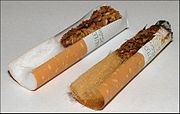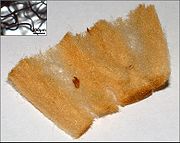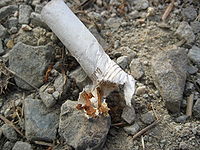
Cigarette filter
Encyclopedia

Tar (tobacco residue)
Tar is the common name for the resinous partially combusted and healed particulate matter produced by the burning of tobacco and other plant material in the act of smoking. Tar is purportedly the most destructive component in habitual tobacco smoking, accumulating in the smoker's lungs over time...
, and fine particles inhaled during the combustion
Combustion
Combustion or burning is the sequence of exothermic chemical reactions between a fuel and an oxidant accompanied by the production of heat and conversion of chemical species. The release of heat can result in the production of light in the form of either glowing or a flame...
of a cigarette
Cigarette
A cigarette is a small roll of finely cut tobacco leaves wrapped in a cylinder of thin paper for smoking. The cigarette is ignited at one end and allowed to smoulder; its smoke is inhaled from the other end, which is held in or to the mouth and in some cases a cigarette holder may be used as well...
. Filters also reduce the harshness of the smoke and keep tobacco flakes out of the smoker's mouth.
History
In 1925, inventor Boris Aivaz patented the process of making a cigarette filter from crepe paperCrêpe paper
Crêpe paper is tissue paper that has been coated with sizing and then creped to create gathers.-Production:Paper that is creped is produced on a paper machine that has a single large steam-heated drying cylinder fitted with a hot-air hood. The raw material is paper pulp. The Yankee cylinder is...
, with some variants including cellulose
Cellulose
Cellulose is an organic compound with the formula , a polysaccharide consisting of a linear chain of several hundred to over ten thousand β linked D-glucose units....
wadding, during experiments at the Ortmann plant of Bunzl
Bunzl
Bunzl plc is a multinational distribution and outsourcing company headquartered in London, United Kingdom. The company is primarily a distributor of a diverse range of non-food consumable products including food packaging, cleaning and hygiene supplies, personal protective equipment and carrier...
. Aivaz produced the first cigarette filter from 1927 in co-operation with Bunzl's Filtronic
Filtrona
Filtrona PLC is a supplier of plastic and fibre products. The company operates internationally from headquarters in Milton Keynes in the UK. It is listed on the London Stock Exchange and is a constituent of the FTSE 250 Index.-History:...
subsidiary, but uptake was low due to a lack of the machinery required to produce cigarettes with the filtered tip.
From 1935, a British
United Kingdom
The United Kingdom of Great Britain and Northern IrelandIn the United Kingdom and Dependencies, other languages have been officially recognised as legitimate autochthonous languages under the European Charter for Regional or Minority Languages...
company began to develop a machine that made cigarettes incorporating the tipped filter. It was considered a speciality item until 1954, when manufacturers introduced the machine more broadly, following a spate of speculative announcements from doctors
Physician
A physician is a health care provider who practices the profession of medicine, which is concerned with promoting, maintaining or restoring human health through the study, diagnosis, and treatment of disease, injury and other physical and mental impairments...
and researchers concerning a possible link between lung diseases and smoking. Since filtered cigarettes were considered "safer", by the 1960s, they dominated the market.
With classic filter cigarettes, the filter is covered with a cork-colored mouthpiece. Nowadays, some cigarette brands use a white mouthpiece—especially those marketed to a predominantly female target group. White mouthpieces are also used to signify a menthol
Menthol
Menthol is an organic compound made synthetically or obtained from peppermint or other mint oils. It is a waxy, crystalline substance, clear or white in color, which is solid at room temperature and melts slightly above. The main form of menthol occurring in nature is -menthol, which is assigned...
cigarette in the United Kingdom and a "light" cigarette in the United States
United States
The United States of America is a federal constitutional republic comprising fifty states and a federal district...
.
Most factory-made cigarettes are equipped with a filter; those who roll their own can buy them from a tobacconist.
Manufacture

Cellulose
Cellulose is an organic compound with the formula , a polysaccharide consisting of a linear chain of several hundred to over ten thousand β linked D-glucose units....
(obtained from wood). The cellulose is acetylated (i.e, making it into a material called celluose acetate or simply "acetate" for short), dissolved, and spun as continuous synthetic fibers arranged into a bundle called tow
Tow
In the composites industry, a tow is an untwisted bundle of continuous filaments, and it refers to man-made fibres, particularly carbon fibres ....
. The cellulose is a substituted diacetate (actually 2.35 - 2.55 substitution range) cellulose, due to its chemical and physical processing. This tow is opened, plasticized, shaped, and cut to length to act as a filter.
In the early 1950s, Kent
Kent (cigarette)
Kent is a brand of cigarettes. Kent's Micronite filter was introduced shortly after the publication of a series of articles in Reader's Digest in 1952 entitled "Cancer by the Carton", that scared American consumers into seeking out a filter brand at a time when most brands were filterless...
brand cigarettes used crocidolite asbestos
Asbestos
Asbestos is a set of six naturally occurring silicate minerals used commercially for their desirable physical properties. They all have in common their eponymous, asbestiform habit: long, thin fibrous crystals...
as part of the (Micronite) filter. Asbestos fiber is heatproof, insoluble and forms extremely fine fibers — but has been proven to cause lung cancer when inhaled. Other filter variations include Lark
Lark (cigarette)
Lark is a brand of cigarettes introduced in 1963 by Liggett & Myers and notable for its charcoal filter and past advertising campaigns, among which was one featuring people on the street being asked to "Show us your Lark pack".-Brand history and ownership:...
cigarettes, which featured a chamber filled with activated charcoal granules.
The U.S. Department of Agriculture
United States Department of Agriculture
The United States Department of Agriculture is the United States federal executive department responsible for developing and executing U.S. federal government policy on farming, agriculture, and food...
price support for the various grades of tobacco favored the use of #4 and 5 grade, which included what were known as sand lugs and floor sweepings at 10 cents/lb versus #1 grade at close to 70 cents. During the 1940s, it was less expensive to manufacture a filtered cigarette than a regular one.
Light cigarettes
In light cigarettes and some full flavor cigarettes, the filter is perforated with tiny holes that dilute the smoke with air. As such, the inhaled smoke contains less tar and nicotineNicotine
Nicotine is an alkaloid found in the nightshade family of plants that constitutes approximately 0.6–3.0% of the dry weight of tobacco, with biosynthesis taking place in the roots and accumulation occurring in the leaves...
. In theory, this should make the cigarette "safer" than full flavor ones. In practice, however, the average smoker compensates by inhaling more deeply or by covering parts of the holes with fingers or lips. Because of this, smokers of light cigarettes can be exposed to equal or greater doses of carcinogens and tar than they would be with medium tar cigarettes.
Disposal
Most cigarette filters are made from cellulose acetateCellulose acetate
Cellulose acetate , first prepared in 1865, is the acetate ester of cellulose. Cellulose acetate is used as a film base in photography, as a component in some adhesives, and as a frame material for eyeglasses; it is also used as a synthetic fiber and in the manufacture of cigarette filters and...
. Depending on conditions, estimates for the time taken for them to degrade range from British American Tobacco's
British American Tobacco
British American Tobacco p.l.c. is a global tobacco company headquartered in London, United Kingdom. It is the world’s second largest quoted tobacco company by global market share , with a leading position in more than 50 countries and a presence in more than 180 countries...
1 month - 3 years, to 10–15 years.

See also
- Cigarette holderCigarette holderA cigarette holder is a fashion accessory, a slender tube in which a cigarette is held for smoking. Most frequently made of silver, jade or bakelite , cigarette holders were considered an essential part of ladies' fashion from the mid-1910s through the early-1970s, and are still widely popular...
- NicotineNicotineNicotine is an alkaloid found in the nightshade family of plants that constitutes approximately 0.6–3.0% of the dry weight of tobacco, with biosynthesis taking place in the roots and accumulation occurring in the leaves...
- Tobacco smokingTobacco smokingTobacco smoking is the practice where tobacco is burned and the resulting smoke is inhaled. The practice may have begun as early as 5000–3000 BCE. Tobacco was introduced to Eurasia in the late 16th century where it followed common trade routes...
- List of cigarette smoke constituents
- List of additives in cigarettes
External links
- How stuff works: Cigarette filters
- Article on Tobacco Control website on the "defective design" of cigarette filters ("Essentially, this journal offers a one-stop shopping guide for anti-smoking literature and other resources." - Philip Morris 1992.)
- http://www.pbs.org/wgbh/nova/cigarette/anat_text.htmlPBSPublic Broadcasting ServiceThe Public Broadcasting Service is an American non-profit public broadcasting television network with 354 member TV stations in the United States which hold collective ownership. Its headquarters is in Arlington, Virginia....
's NOVANOVA (TV series)Nova is a popular science television series from the U.S. produced by WGBH Boston. It can be seen on the Public Broadcasting Service in the United States, and in more than 100 other countries...
Search for a Safer Cigarette] - UCSF Tobacco Industry Videos Collection
- UCSF Tobacco Industry Audio Recordings Collection

